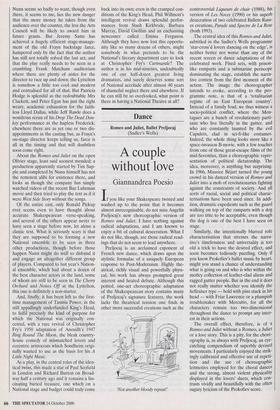Dance
A couple without love
Giannandrea Poesio
If you like your Shakespeare twisted and washed up to the point that it becomes almost unrecognisable, do not miss Angelin Preljocaj's new choreographic version of Romeo and Juliet. I have nothing against radical adaptations, and I am known to enjoy a bit of cultural desecration, What I do not like, though, are those radical read- ings that do not seem to lead anywhere.
Preljocaj is an acclaimed exponent of French new dance, which draws upon the stylistic formulae of a uniquely European response to Post-Modernism. Highly the- atrical, richly visual and powerfully physi- cal, his work has always prompted great interest and heated debate. Although this potted, one-act choreographic adaptation of the Shakespearean story contains many of Preljocaj's signature features, the work lacks the theatrical tension one finds in other more successful creations such as the Not another bloody repeat!' controversial Liqueurs de chair (1988), his version of Les Noces (1990) or his superb desecration of two celebrated Ballets Russ- es creations, Parade and Spectre de La Rose (both 1993).
The central idea of this Romeo and Juliet, subtitled in the Sadler's Wells programme `star-cross'd lovers dancing on the edge', is neither better nor worse than any of the recent screen or dance adaptations of the celebrated work. Fixed sets, with prison- like ramparts and a submarine periscope dominating the stage, establish the narra- tive context from the first moment of the action. The image the choreographer intends to evoke, according to the pro- gramme note, is that of a 'totalitarian regime of an East European country'. Instead of a family feud, we thus witness a socio-political conflict, where the Mon- tagues are a bunch of revolutionary parti- sans who live literally in the gutter, and who are constantly taunted by the evil Capulets, clad in sci-fi-like costumes. Indeed, the whole thing looks more like a space-invasion B-movie, with a few touches from one of those great-escape films of the mid-Seventies, than a choreographic repre- sentation of political dictatorship. The idea, moreover, is anything but surprising. In 1966, Maurice Bejart turned the young crowd in his danced version of Romeo and Juliet into a mob of revolutionaries fighting against the constraints of society. And all sorts of racial, social and political charac- terisations have been used since. In addi- tion, dramatic expedients such as the guard walking on top of the ramparts with a dog are too trite to be acceptable, even though the dog is one of the best I have seen on stage.
Similarly, the intentionally blurred role characterisation that stresses the narra- tive's timelessness and universality is too old a trick to have the desired effect, and soon becomes tediously puzzling. Only if you know Prokofiev's ballet music by heart, might you stand a chance of understanding what is going on and who is who within the motley collection of leather-clad aliens and ragged gutter people. But in the end it does not really matter whether you identify the hellraiser type — bold with pins stuck in his head — with Friar Lawrence or a plumpish troublemaker with Mercutio, for all the characters remain too two-dimensional throughout the dance to prompt any inter- est in their actions.
The overall effect, therefore, is of a Romeo and Juliet without a Romeo, a Juliet or a love story. This is a pity, for the chore- ography is, as always with Preljocaj, an eye- catching compendium of superbly devised movements. I particularly enjoyed the strik- ingly calibrated and effective use of repeti- tion and the use of choreographic leitmotivs employed for the choral dances and the strong, almost violent physicality displayed in the lovers' duets, which con- trasts vividly and beautifully with the often sugary lyricism of the Prokofiev score.


















































































 Previous page
Previous page